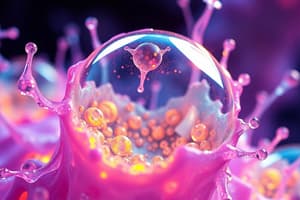Podcast
Questions and Answers
What is the primary purpose of fixation in tissue preparation?
What is the primary purpose of fixation in tissue preparation?
- To visualize live cells during observation
- To increase the water content of the tissue
- To provide nutrients to the tissues
- To preserve morphological features of the tissue (correct)
Which of the following microscopy techniques is best for ultrastructural studies?
Which of the following microscopy techniques is best for ultrastructural studies?
- Fluorescence microscopy
- Phase contrast microscopy
- Confocal microscopy
- Electron microscopy (correct)
Which microscopy technique produces bright images from fluorescent substances?
Which microscopy technique produces bright images from fluorescent substances?
- Scanning electron microscopy
- Dark-field microscopy
- Phase contrast microscopy
- Fluorescence microscopy (correct)
What is one common effect of tissue fixation?
What is one common effect of tissue fixation?
How does dark-field microscopy illuminate the specimen?
How does dark-field microscopy illuminate the specimen?
What replaces extracellular water during tissue processing?
What replaces extracellular water during tissue processing?
What technology is used in confocal microscopy for imaging?
What technology is used in confocal microscopy for imaging?
Which fixative is commonly used and acts as a cross-linker?
Which fixative is commonly used and acts as a cross-linker?
Which microscopy technique provides a view of the surface structure?
Which microscopy technique provides a view of the surface structure?
What is a key limitation of dark-field microscopy?
What is a key limitation of dark-field microscopy?
Flashcards are hidden until you start studying
Study Notes
Types of Microscopes
- Dark-field Microscopy: Illuminates specimen from the side; only scattered light enters the objective, showcasing bright objects on a dark background; useful for imaging small particles like bacteria; produces low-resolution images with limited detail.
- Phase Contrast Microscopy: Enhances the contrast in transparent specimens; ideal for unstained or living cells by differentiating objects with slight variations in refractive index or thickness.
- Differential Interference Contrast Microscopy: Similar to phase contrast, enhances the visualization of unstained specimens, particularly living cells by exploiting differences in optical thickness.
- Fluorescence Microscopy: Utilizes ultraviolet light to excite fluorochromes, resulting in visible fluorescence against a dark background; involves natural primary fluorescent substances and secondary fluorescence from added dyes.
- Confocal Microscopy: Employs a laser to illuminate specimens in a point-scan method, collecting images in an X-Y raster pattern; images are digitized and stored for high-resolution visualization.
- Electron Microscopy: Utilizes accelerated electrons instead of light for imaging; offers a resolving power of 0.2 nm; includes:
- Transmission Electron Microscopy (TEM): Electrons pass through thin tissue sections (less than 100 nm); requires special preparation with ultramicrotome and glass knives; used for detailed ultrastructural studies.
- Scanning Electron Microscopy (SEM): Electrons are reflected from the surface to provide detailed surface views of specimens.
Tissue Processing
- Tissue Collection: Samples obtained from autopsies, surgical procedures, or experimental animals while adhering to ethical guidelines.
- Fixation: Ensures stained sections retain clear morphological features; preserves tissue by coagulating proteins, minimizing loss, and hardening the tissue; vital fixatives include formaldehyde (a cross-linking agent) and glutaraldehyde.
- Effects of Fixation: Stabilizes tissue structure, making it resistant to osmotic changes; formaldehyde is soluble in water (40% solution) and often contains 10% methanol to stabilize; paraformaldehyde is a solid form of formaldehyde, used in various applications.
- Tissue Processing: Involves replacing extracellular water with a medium that provides the necessary rigidity for sectioning, helping prevent damage or distortion during preparation.
Studying That Suits You
Use AI to generate personalized quizzes and flashcards to suit your learning preferences.




